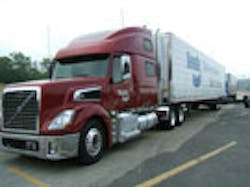Washington D.C. - The Heavy Duty Manufacturers Association (HDMA) hopes to win a tax credit to encourage more fleets to install a variety of new and soon-to-be-available technologies that can vastly improve the “safety signature” of heavy commercial trucks.
“We’re lobbying for a $1,000 to $1,500 tax credit for truck safety systems,” Tim Kraus, president & COO of HDMA and its parent organization the Motor & Equipment Manufacturers Association (MEMA) told FleetOwner. “The safety systems available for heavy trucks today are amazing stuff but also expensive, so we need to find ways to encourage fleets to buy it.”
At a special ride-and-drive event conducted at Robert F. Kennedy Memorial stadium here for members of Congress, federal officials, and other transportation professionals, MeritorWabco, Bendix, and Delphi conducted live demonstrations of their heavy truck safety technologies products.
The MeritorWabco Collision Mitigation System (CMS), for example, uses forward-looking radar in combination with adaptive cruise control (ACC) and control of the truck’s engine, engine brake, and foundation brakes to maintain safe following distances between the truck and other vehicles on the highway. The company is currently in the final stages of testing a full-time version of CMS that would provide forward object detection and braking whether or not the cruise control is activated, said Bill Schlak, technical manager for MeritorWabco.
“We’re talking about a vast improvement in truck safety here,” Alan Korn, chief engineer for MeritorWabco, told FleetOwner. “No matter the distraction to the driver, the radar is always looking forward and can apply the brakes if need be.” While pricing is not yet finalized, the company said a CMS package with active braking is targeted to cost around $2,000 per truck.
According to John Bielis, Delphi’s consumer manager-- electronics & safety, the firm’s new integrated radar package for commercial trucks, due to launch in 2008, incorporates forward- and side-view radar to provide blind spot detection and collision avoidance. While the system isn’t tied into the brakes – thus only giving the driver audible and visual warnings – it’s easy to retrofit onto existing trucks, with radar units small enough to fit under the grill and be hidden behind plastic or fiberglass panels (steel would block the radar beam), noted Bielis.
“It’s a stand alone system so fleets don’t have to go out and buy a new truck to improve safety,” Bielis told FleetOwner. “We just pick up two simple inputs from the truck – vehicle speed and turn indicator activation.” He said the cost of the package will be between $1,500 and $2,500.
Despite the safety and cost-saving advantages such safety technologies provide, it’s been slow going in terms of adoption. For example, Bendix said it’s installed roughly 25,000 of its electronic stability program (ESP) systems – but that only represents some 5% of new heavy truck sales, which topped 300,000 last year, said Fred Andersky, Bendix’s marketing manager for electronics.
“We position ESP like health insurance – you need to have it just in case something goes wrong,” he told FleetOwner. “Just like you don’t wake up one morning and say ‘I think I’ll get sick today,’ a truck driver doesn’t get up and say, ‘I think I’ll roll over my truck this morning.’ Technology like this is insurance for the unexpected.”
And the unexpected can be costly. Bendix pointed out that on average 40 truck rollovers occur every day in the U.S. According to U.S. government data, a truck accident that causes injuries can cost a fleet $300,000, while one involving a fatality can cost upwards of $3 million.
“Preventing even just one rollover can end up paying for the complete installation of safety systems like our ESP for an entire fleet,” said Andersky. “It’s why this and other technologies make such sense.”
About the Author
Sean Kilcarr
Editor in Chief
Sean Kilcarr is a former longtime FleetOwner senior editor who wrote for the publication from 2000 to 2018. He served as editor-in-chief from 2017 to 2018.
